This article was co-authored by wikiHow staff writer, Jennifer Mueller, JD. Jennifer Mueller is a wikiHow Content Creator. She specializes in reviewing, fact-checking, and evaluating wikiHow's content to ensure thoroughness and accuracy. Jennifer holds a JD from Indiana University Maurer School of Law in 2006.
wikiHow marks an article as reader-approved once it receives enough positive feedback. In this case, 92% of readers who voted found the article helpful, earning it our reader-approved status.
This article has been viewed 405,886 times.
Learn more...
Whether you're traveling to an Arabic country or just want to greet an Arabic friend in their native tongue, learning how to greet people is a good way to get started with the Arabic language and culture. The most common Arabic greeting is "as-salaam 'alaykum," which means "peace be upon you." While this is technically a Muslim greeting, it's used throughout the Arab world. You can also say "ahlan," which simply means "hello." As with any language, however, there are other ways to greet people in Arabic, depending on the context and how well you know the person.[1]
Steps
Saying "Hello" in Arabic
-
1Use "as-salaam 'alaykum" as a default greeting. The greeting "as-salaam 'alaykum" literally means "peace be upon you," and is a traditional greeting among Muslims. Because the majority of Arabs are Muslims, it is also the most common Arabic greeting.[2]
- The response to this greeting is "wa 'alaykum as-salaam," which essentially means "and also with you."
- If you are in an Arabic country, this is a good default greeting whether you know the religious beliefs of the person you're greeting or not. Outside Arabic countries, however, you may want to use a different greeting if you know the person you're greeting is not Muslim.
-
2Switch to "ahlan" if you aren't comfortable with religious greetings. "Ahlan" is the basic way to say "hello" in Arabic, and is suitable for all occasions. If you're not Muslim or don't feel comfortable giving a Muslim greeting, you can use this instead.[3]
- "Ahlan wa sahlan" is the more formal version of "ahlan." Use this with people older than you or in a position of authority.
- The response to "ahlan" is "ahlan bik" (if you are male) or "ahlan biki" (if you are female). If someone says "ahlan" to you first, remember to adjust your response depending on whether they are male or female.
Tip: You may hear Arab-speakers using English greetings as well. However, these are considered relatively casual or familiar. Avoid them unless you know the person well or they've used an English greeting with you first.
Advertisement -
3Try "marhaba" to welcome someone. This word literally means "welcome," and is typically used when you're welcoming someone into your home or the place you happen to be staying. You can also use it to invite someone to come and sit with you. It's also used simply to mean "hi" or "hello" more casually.[4]
- For example, if you're sitting at a café and a friend passes and says "ahlan," you might reply "marhaba," to indicate that they can come and sit with you for a chat.
-
4Alter your greeting based on the time of day. There are also time-specific greetings in Arabic that you can use in the morning, afternoon, or evening. While these aren't as common, you can use them if you feel like it. They're considered relatively formal, so they're appropriate regardless of who you're greeting.[5]
- In the morning, say "sabaahul khayr" (good morning).
- In the afternoon, say "masaa al-khayr" (good afternoon).
- In the evening, say "masaa al-khayr" (good evening).
Tip: The phrase for "good night" is "tusbih alaa khayr." This phrase is typically used as a form of "goodbye" at the end of an evening, however — not as a greeting.
-
5Ask how the person is doing. As in other languages, it's common to ask after someone's welfare immediately after greeting them. In Arabic, the basic question differs depending on whether you're speaking to a man or a woman.[6]
- If you're speaking to a man, ask "kayfa haalak?" He will likely respond "ana bekhair, shukran!" (which essentially means "I'm fine, thanks!"
- If you're speaking to a woman, ask "kayfa haalik?" The response is typically the same as it would be for a man.
- If the other person asks you how you're doing first, respond "ana bekhair, shukran!" and then follow up with "wa ant?" (if the person is a man) or "wa anti?" (if the person is a woman. These phrases essentially mean "and you?"
-
6Continue the conversation if you feel comfortable. If you know very little Arabic, at this point, you may want to say: "Hal tatahadath lughat 'ukhraa bijanib alearabia?" ("Do you speak a language other than Arabic?") However, if you've been studying and feel you can hold your own in a basic conversation, you might continue by asking the person their name or where they're from.[7]
- If you and the person you've greeted don't have any other languages in common and you want to attempt to continue speaking in Arabic, you might let them know that you only know a little Arabic. Say "na'am, qaliilan," to indicate that you only speak a little Arabic.
- If you don't understand what the person is saying, you might say "laa afham" (I don't understand).
Observing Arab Customs and Traditions
-
1Use polite words and phrases to show respect. In any language, minding your manners shows respect. Using polite words and phrases in Arabic, even if you don't know any other words in the language, communicates that you respect Arab culture. Some words to learn include:[8]
- "Al-ma'dirah": Excuse me (if you're asking someone to move)
- "Aasif": Sorry
- "Miin faadliikaa": Please
- "Shukran": Thank you
- "Al'afw": Reply to "thank you"
-
2Avoid touching when greeting someone of a different gender. Traditionally, men and women do not touch each other at all when greeting, unless they are close family members. Some women are willing to shake hands with men, particularly in more formal contexts. However, if you are a man, you should let the woman take the lead.[9]
- Stand away from the woman as you greet her. If she is willing to shake your hand, she will extend her hand to you. Don't automatically extend your hand first.
- If she clasps her hands together or places her right hand over her heart, that is an indication that she isn't willing to shake hands but is nonetheless pleased to meet you.
-
3Shake hands when greeting someone of the same gender formally. When greeting someone of the same gender as you in a formal context, such as in a professional environment or for school, shaking hands is common. It's still a good idea to let the other person take the lead and offer their hand first.[10]
- Always shake with your right hand, never your left. The left hand is considered unclean in Arab culture.
-
4Place your right hand on your heart to greet someone warmly. Placing your right hand over your heart indicates that even though you're not going to touch the person, you're still quite pleased to meet them. If you have Arabic friends of a different gender, this is an appropriate way to greet them.[11]
- Because men and women who aren't related to each other typically don't touch each other when greeting, this gesture is a way to signify your attachment to the person you're greeting without hugging or kissing them.[12]
-
5Touch noses or kiss cheeks with people you know well. In Arabic culture, touching noses is not considered a particularly intimate gesture and is frequently done between two men as well as between two women. Another gesture popular in some areas is to place 3 kisses on the other person's right cheek.[13]
- These gestures are typically never appropriate with someone of a different gender unless you are related to them and have a very close relationship. Even then, many Arabs would not consider such a greeting appropriate in public.
Tip: Women (but not men) also occasionally hug each other when greeting. Hugs are reserved for family members or close friends who you know very well.
-
6Greet an elder with a kiss on the forehead. Elders are greatly respected in Arabic culture. A kiss on the forehead honors them and shows them respect. Reserve this gesture for elders you know well, or who are related to someone you know well.[14]
- For example, if your Qatari friend introduces you to his grandmother, you might kiss her on the forehead when greeting her.
Community Q&A
-
QuestionWhat do Arabs do when they greet each other?
 Community AnswerIf it is a new person or a formal greeting, shake hands with your right hand. If you are meeting a friend or family member, it is customary to shake hands and kiss each other on each cheek.
Community AnswerIf it is a new person or a formal greeting, shake hands with your right hand. If you are meeting a friend or family member, it is customary to shake hands and kiss each other on each cheek. -
QuestionHow do I spell bismala?
 Community AnswerI believe you mean "bismillah", which means "in God's (Allah's) name". It's a shortened form of Bismi llaahi In Arabic it's written بسم الله, and it's comprised three different parts; ب "bi" which means in, اسم "ism" which means name, and الله "Allah" which means God.
Community AnswerI believe you mean "bismillah", which means "in God's (Allah's) name". It's a shortened form of Bismi llaahi In Arabic it's written بسم الله, and it's comprised three different parts; ب "bi" which means in, اسم "ism" which means name, and الله "Allah" which means God. -
QuestionIs it common in the Middle East for a woman to shake hands with a man (in a formal greeting)?
 Community AnswerWell, the Middle East has evolved and it is not unusual for a woman to shake hands with a man in a formal setting (e.g. a business meeting.) Just make sure you have consent before touching anyone, regardless of gender.
Community AnswerWell, the Middle East has evolved and it is not unusual for a woman to shake hands with a man in a formal setting (e.g. a business meeting.) Just make sure you have consent before touching anyone, regardless of gender.
Warnings
- This article uses transliterated Arabic. Pronunciations are approximate and may vary depending on the dialect used. To pronounce the words correctly, listen to a native speaker and mimic their pronunciation.⧼thumbs_response⧽
References
- ↑ https://www.omniglot.com/language/phrases/arabic.php
- ↑ https://www.dayoutdubai.ae/blog/safari/greeting-in-arabic/
- ↑ https://www.dayoutdubai.ae/blog/safari/greeting-in-arabic/
- ↑ https://www.dayoutdubai.ae/blog/safari/greeting-in-arabic/
- ↑ https://www.omniglot.com/language/phrases/arabic.php
- ↑ https://www.omniglot.com/language/phrases/arabic.php
- ↑ https://www.omniglot.com/language/phrases/arabic.php
- ↑ https://www.omniglot.com/language/phrases/arabic.php
- ↑ https://culturalatlas.sbs.com.au/saudi-arabian-culture/saudi-arabian-culture-greetings
- ↑ https://culturalatlas.sbs.com.au/saudi-arabian-culture/saudi-arabian-culture-greetings
- ↑ https://www.cultureready.org/blog/body-language-arab-world
- ↑ https://www.lebanesearabicinstitute.com/hello-in-lebanese-arabic/
- ↑ https://culturalatlas.sbs.com.au/saudi-arabian-culture/saudi-arabian-culture-greetings
- ↑ https://culturalatlas.sbs.com.au/saudi-arabian-culture/saudi-arabian-culture-greetings
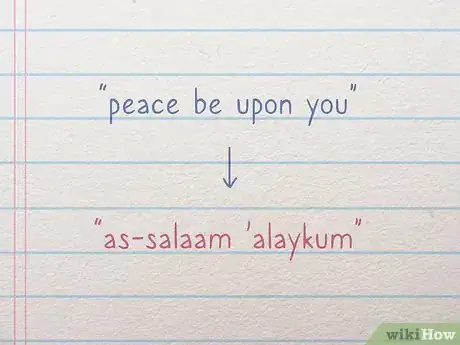


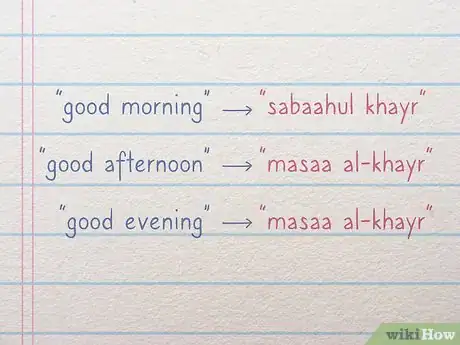
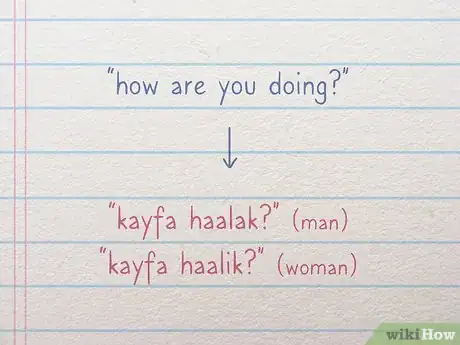
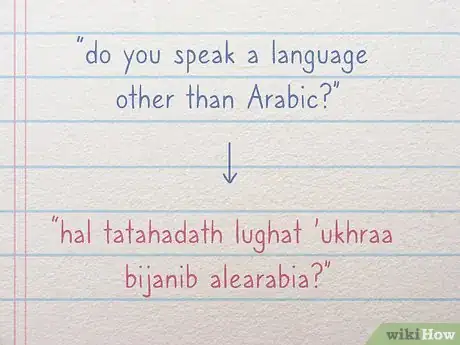
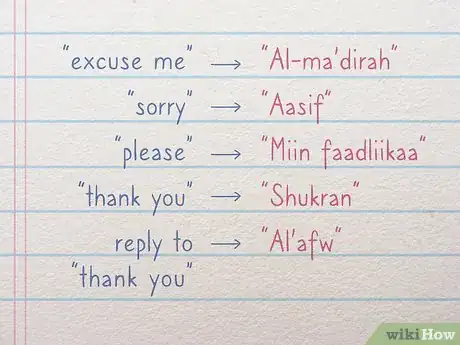


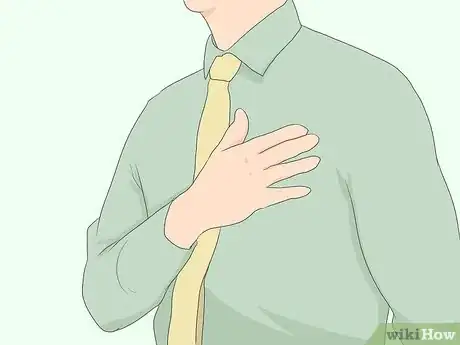


-Step-3-Version-2.webp)



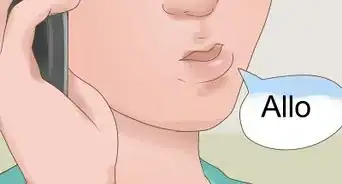




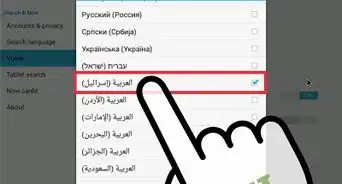










-Step-3-Version-2.webp)





































